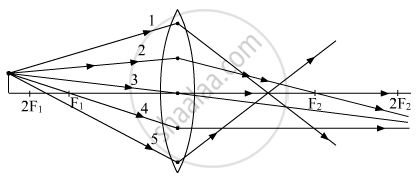Advertisements
Advertisements
Question
An object 4 cm high is placed at a distance of 10 cm from a convex lens of focal length 20 cm. Find the position, nature and size of the image.
Solution
Given:
Object distance, u = -10 cm (It is to the left of the lens.)
Focal length, f = + 20 cm (It is a convex lens.)
Putting these values in the lens formula, we get:
1/v- 1/u = 1/f (v = Image distance)
1/v -1/-10) = 1/20
or, v =-20 cm
Thus, the image is formed at a distance of 20 cm from the convex lens (on its left side).
Only a virtual and erect image is formed on the left side of a convex lens. So, the image formed is virtual and erect.
Now,
Magnification, m = v/u
m =-20 / (-10) = 2
Because the value of magnification is more than 1, the image will be larger than the object.
The positive sign for magnification suggests that the image is formed above principal axis.
Height of the object, h = +4 cm
magnification m=h'/h (h=height of object)
Putting these values in the above formula, we get:
2 = h'/4 (h' = Height of the image)
h' = 8 cm
Thus, the height or size of the image is 8 cm.
APPEARS IN
RELATED QUESTIONS
Analyse the following observation table showing variation of image-distance (v) with object-distance (u) in case of a convex lens and answer the questions that follow without doing any calculations :
| S. No. | Object-Distance u (cm) |
Image-Distance v (cm) |
| 1 | –100 | +25 |
| 2 | –60 | +30 |
| 3 | –40 | +40 |
| 4 | –30 | +60 |
| 5 | –25 | +100 |
| 6 | –15 | +120 |
(a) What is the focal length of the convex lens? Give reason to justify your answer.
(b) Write the serial number of the observation which is not correct. On what basis have you arrived at this conclusion?
(c) Select an appropriate scale and draw a ray diagram for the observation at S.No. 2. Also find the approximate value of magnification.
For what position of an object a real, diminished image is formed by a convex lens?
Fill in the following blank with suitable word:
The image in a convex lens depends upon the distance of the ........... from the lens.
What is a lens?
You eye contains a convex lens. Why is it unwise to look at the sun?
Out of the five incident rays shown in the figure find the three rays that are obeying the laws of refraction and may be used for locating the position of image formed by a convex lens:
(A) 1, 2 and 3
(B) 2, 3 and 4
(C) 3, 4 and 5
(D) 1, 2 and 4
(a) What type of a lens can be used as a magnifying glass?
(b) Show by a ray diagram the formation of a real image by simple magnifying lens.
A concave mirror and convex lens are held in water. What changes, if any, do you expect in their focal length?
Which lens can produce a real and inverted image of an object?
Find the odd one out and give its explanation.
